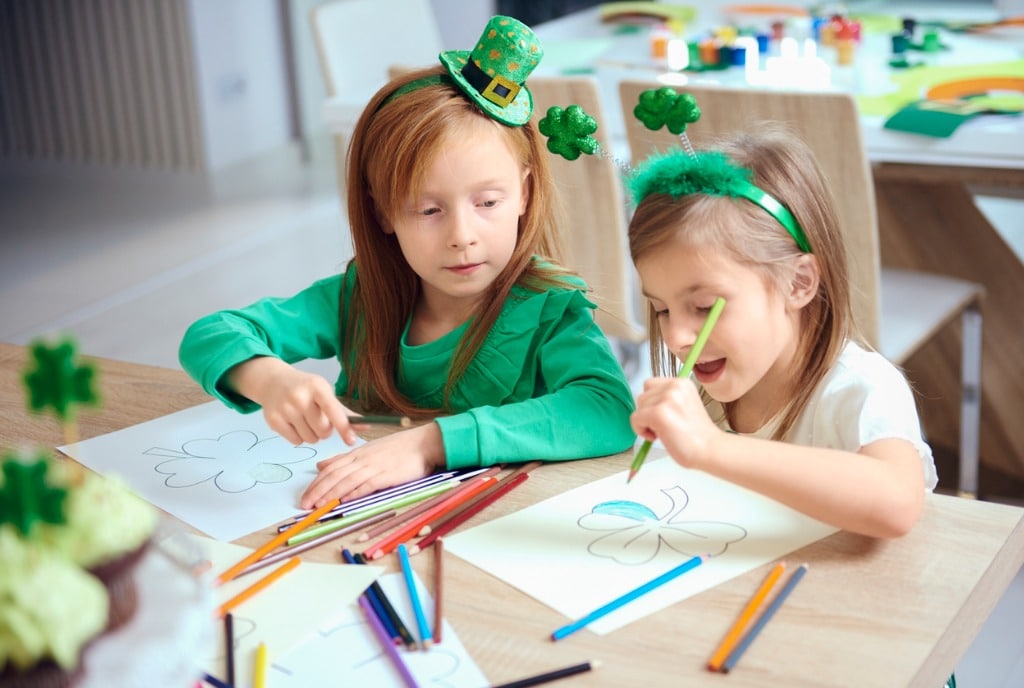St. Patrick’s Day is a holiday that observes the life of St. Patrick, the patron saint of Ireland, by displaying Irish iconographies like golden coins, shamrocks, rainbows, leprechauns and the color green as a way to bring ‘the luck o’ the Irish’ to America.
You can introduce your students to this celebration of Irish culture and invite some luck into your classroom with these fun activities covering math, science, English, art and history—it’s enough to fill an entire day of lesson plans for St. Paddy’s Day!
Math Activities for St. Patrick’s Day
Lucky Charms Arithmetic
Students can practice counting and graphing using Lucky Charms, the classic favorite breakfast cereal with a leprechaun mascot! Portion out a ½ cup to 1 cup of cereal per student, then have them count and record the number of marshmallows and cereal pieces they find in their portion. Once they have the raw data, they can express it with a bar graph!
You can also collect all the data from all of your students, add it up and write it on the whiteboard at the front of your classroom or in a shared Google Doc. For younger students, lead a discussion about how the different amounts of marshmallows compare to each other and how the number of marshmallows compares to the amount of cereal. For older elementary students, you can also use this activity in lessons on fractions and probability.
Learn to Count in Gaelic
Math is language, so that makes it a great entry point into other languages! Celebrate Irish culture and learn different ways that math is used across cultures by teaching students how to count from 1 to 10 in the Irish language.
- a haon
- a dó
- a trí
- a ceathair
- a cúig
- a sé
- a seacht
- a hocht
- a naoi
- a deich
You’ll want to watch a video that teaches proper pronunciation of the words and repeat it several times while having the class repeat the words. Then, repeat the words again without the video’s help. After this, lead a discussion about how languages describe numbers.
The English language has two ways of counting: cardinal numbers (one, two, three, etc.) and ordinal numbers (first, second, third, etc.), in addition to other words that are also used for specific numbers (couple, decade, centennial, etc). The Irish language is unique in that it has two different types of cardinal numbers: cardinal numbers for objects and cardinal numbers for people!
Ask students to think about other words that have numerical meanings and to think about the difference between words that have specific numerical meanings (a dozen is 12) and general numerical meanings (a few is generally more than two and has no stated upper limit, but most people have an intuitive upper-limit for how many it means). Ask students why we have numerical words that don’t have a specific numerical meaning and when those terms are useful to use over more specific numerical words.
Science Activities for St. Patrick’s Day
 Green Slime Experiment
Green Slime Experiment
Use a slime recipe to teach students about the different states of matter and other chemistry concepts! You can explain as you go and have students write down their impressions and observations while completing this fun chemistry lab with a green and glittery take-home slime for them to keep.
Beyond its benefits of sensory play, slime is a fun introduction to science concepts like mixtures, substances, polymers, cross-linking, elasticity, viscosity and states of matter: since slime isn’t a liquid or a solid, it’s referred to as a non-Newtonian fluid.
Ingredients
Liquid starch, Elmer’s glue, water, fun mix-ins (glitter, confetti, food coloring and/or plastic gold coins)
Instructions
- In a bowl, mix ½ cup water and ½ cup glue; mix well until completely combined
- Add color, glitter, confetti or other mix-ins
- Add ¼ cup liquid starch. The slime will immediately begin to form. Stir slime until it’s at a gooey blobby consistency with no liquid remaining.
- Knead the slime. It will start out stringy but form into a denser and more cohesive consistency as you keep kneading. Knead well until it has the proper consistency.
- Store slime in an air-tight container like a plastic or glass jar or a plastic baggy to improve its longevity (if slime is kept clean, it should last for several weeks).
Are you Enjoying this Content?
Go Green for St. Patrick’s Day (and Every Day!)
Teach students about the importance of conservation and recycling by turning old plastic milk jugs or 2-liter soda bottles into planters for herbs, flowers or grass. This project can be a one-day activity that ends with students taking their new plants home with them, or it can contribute to multiple weeks’ worth of lessons as students water their plants and watch them grow.
For more experimentation, have students guess whether their plants will grow better by adding Miracle Grow (or a similar plant nutrient mix) or baking soda. Then, watch the results as the plants develop in response to the students’ chosen additives. While working through this project, ask your class what plants need to grow healthy and strong, and encourage students to make a list of small actions they can do every day to help protect the planet!
English Activities for St. Patrick’s Day
Lucky Gratitude Journal
Gratitude and mindfulness are both important aspects of social-emotional learning, and a fun way to make these practices more festive for St. Patrick’s Day is to teach students about the everyday luck in their lives. Explain to students that ‘lucky’ means something good happening to you that you had little or nothing to do with, like finding a four-leafed clover in the park or finding out a movie you want to watch is available on a streaming service your family has.
Once everyone is clear on what luck is, have them write a short paragraph about something lucky in their lives. This activity is great for St. Patrick’s Day, and you can continue to have your class reflect on different topics related to gratitude throughout the year to practice writing while engaging in a grounding exercise they can benefit from throughout their lives.
Story Starters
Inspire your students to think creatively and write a story with St. Patrick’s Day-themed story starters! Encourage them to think about characters, conflict and resolution (make sure their stories have all three!). Fun story starters for St. Patrick’s Day include ‘If I had a pot of gold, I would…’ ‘I went to the end of the rainbow, and I found…’ ‘When I met a leprechaun, they told me…’ and ‘I went looking for a four-leafed clover because…’
These story starters can be pasted onto St. Patrick’s Day-themed cut-outs, made into a lined page with a festive border in Word, made into a template students can fill out in Google Docs or written on the whiteboard at the front of the classroom and copied by students onto a blank page where they continue the story.
This is an excellent activity to turn into a free classbook from Studentreasures! Simply click the link to sign up for one of our free classbook publishing kits that will walk you through the process of helping your students become published authors by turning their writing and illustrations into a real published book you can keep in your classroom, with the option for parents to order additional copies as a memento for the future!
 Leprechaun Trapping!
Leprechaun Trapping!
Have your students use critical thinking, the imperative voice and sequence writing to make a plan to catch a leprechaun! Create printable worksheets in Word or download templates in Google Docs for brainstorming the materials they’ll need to collect and what their trap will look like, with planning sections labeled ‘first,’ ‘then,’ ‘next’ and ‘finally’ for students to fill out.
Take this to the next level by dividing the class into groups of three or four students each and have them work through the thought experiment together as they fill out the worksheets. After the activity is over, have them present their ideas to the class and lead a discussion about the best tactics to use to catch a leprechaun by combining all of the ideas your students have devised to create a master plan!
Leprechaun Limericks
Limericks are a great activity for upper elementary students who are being introduced to different poetic forms. Explain that limericks are silly poems consisting of five lines with a rhyming scheme of AABBA. The first, second and fifth lines rhyme with each other and usually have eight or nine syllables each; the third and fourth lines rhyme with each other and usually have five or six syllables each.
Most limericks start with “There once was a…” and then introduce a character or setting, with the rest of the lines expanding on the scenario until the fifth line punchline. Read a few examples and then have students write their own St. Patrick’s Day-themed limericks to share with the class!
Art Activities for St. Patrick’s Day
Leprechaun Head Bookmark
Dog-eared pages and creased spines are signs of well-loved books and using a bookmark will help students keep their favorites in good condition for longer. Create a leprechaun bookmark out of construction paper by gluing a green hat-shaped piece of paper onto a circle-shaped piece of construction paper to make a head.
Then, let students personalize their leprechaun by gluing decorations such as a buckle and four-leafed clover to the hat, and different facial features to the face, such as a beard, eyebrows, eyes, a mouth and rosy cheeks. Read or play a recording of traditional Irish folktales about leprechauns or play traditional Irish music for inspiration while your students complete their bookmarks!
Pipe Cleaner Shamrocks with Beads
All you need is pipe cleaners and pony beads to lead your class in a craft project that will help them develop their fine motor skills, as well as practice counting and pattern matching. Show students how to bend their pipe cleaners into a three- or four-leafed shamrock, then string on some beads to decorate.
Encourage them to plan which beads they’ll use, taking color and pattern into account, and to match the pattern on each leaf. This project looks great using traditional colors like glittery green, white and gold or you can pick up a random color assortment of pipe cleaners and pony beads and allow your students to express their creativity with the full spectrum of the rainbow! Who said there can’t be blue and orange shamrocks? (Nobody, probably.)
History Activities for St. Patrick’s Day
Irish History Acrostic Poetry
Distribute acrostic poem templates with words like ‘St. Patrick,’ ‘leprechaun,’ ‘shamrock’ or other thematically appropriate words, or have students write one of these words vertically on a sheet of paper. Read a book about Irish history or watch a video about Irish facts and have students fill out their acrostics along the way. After the activity is over, have students share their favorite facts with the rest of the class.
Learn to Irish Step Dance
Traditional music is a great way to introduce students to the history and culture of a group of people. Show students some video clips of professional Irish step dancers, then follow up with an easy-to-follow video tutorial breaking down the steps to get students out of their seats and moving!
The steps are complicated, and odds are most students won’t be able to get them exactly right, but this is still a great opportunity to get students on their feet and moving around while learning about an important aspect of Irish culture. There are many Irish step dance videos available for free online, and many video tutorials for beginners just starting out in Irish step dance are ideal for young learners. Discuss the historical importance of Irish step dance in Irish culture or find a video that incorporates historical information into the performance.
Sign Up to Receive Your FREE Classbook Publishing Kit
Many of these St. Patrick’s Day activities would make for a perfect classbook project! Simply sign up to receive your free classbook publishing kit, and we’ll turn your young learners into published authors. Classbooks make for a fabulous keepsake, and your students’ parents can order copies, as well. Don’t forget to wear green!







